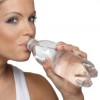
In fact, a study sponsored by the Environmental Working Group (EWG) tested the umbilical cord blood of 10 newborns and found that the samples contained an average of 200 chemicals … chemicals linked to cancer, brain damage, birth defects and more.
“This is conclusive evidence that babies are being exposed to hundreds of industrial chemicals throughout pregnancy,” said Sonya Lunder, an EWG scientist, told the Associated Press. “The placenta isn’t a magic shield.”
The implications of all these chemical exposures are completely unknown, and while it’s likely impossible to eliminate all exposures (most people already have countless environmental chemicals circulating in their bloodstream), it’s a wise idea to minimize your exposure as much as possible during pregnancy and if you’re planning to become pregnant.
Here we’ve compiled a list of some of the worst chemical offenders for developing babies and their moms.


.aspx?width=167&height=250)
.aspx?width=166&height=250) Dental cavities are the most common disease in childhood and the most common chronic disease around the world. Since the 1930s and ‘40s, scientists have been exploring whether there is a genetic predisposition to cavities, or if diet and nutrition are to blame. Unfortunately, there is no absolute answer. Both genetics and nutrition play a role in a person’s predisposition to cavities; however, there is plenty you can do to limit tooth decay and cavities.
Dental cavities are the most common disease in childhood and the most common chronic disease around the world. Since the 1930s and ‘40s, scientists have been exploring whether there is a genetic predisposition to cavities, or if diet and nutrition are to blame. Unfortunately, there is no absolute answer. Both genetics and nutrition play a role in a person’s predisposition to cavities; however, there is plenty you can do to limit tooth decay and cavities..aspx?width=220&height=147) For the first time ever, a study has proven that eating flavonoids, a type of antioxidant that’s especially concentrated in fruits and vegetables, may boost your immune system.
For the first time ever, a study has proven that eating flavonoids, a type of antioxidant that’s especially concentrated in fruits and vegetables, may boost your immune system. High-fructose corn syrup (HFCS) has replaced sugar in many processed foods, and is now found in soft drinks and other sweetened beverages, breads, cereals, lunch meats, soup, condiments, yogurt and much, much more.
High-fructose corn syrup (HFCS) has replaced sugar in many processed foods, and is now found in soft drinks and other sweetened beverages, breads, cereals, lunch meats, soup, condiments, yogurt and much, much more. Accidents are the leading cause of death among toddlers, so keeping your home baby-proof is an essential part of being a parent, grandparent or anyone who has babies and toddlers who visit their home.
Accidents are the leading cause of death among toddlers, so keeping your home baby-proof is an essential part of being a parent, grandparent or anyone who has babies and toddlers who visit their home. Every year, 1.3 million Americans undergo LASIK surgery to correct their vision, and most have good results. In fact, only 2 percent to 3 percent of LASIK (which stands for Laser-Assisted In-Situ Keratomileusis) patients have complications, according to the American Society of Cataract and Refractive Surgery.
Every year, 1.3 million Americans undergo LASIK surgery to correct their vision, and most have good results. In fact, only 2 percent to 3 percent of LASIK (which stands for Laser-Assisted In-Situ Keratomileusis) patients have complications, according to the American Society of Cataract and Refractive Surgery. Over 30 percent of teenagers, and 34 percent of 18- to 24-year-olds, consume energy drinks on a regular basis, according to a report by the Marin Institute. These drinks are heavily marketed to teens as a harmless way to boost energy, but in reality they’ve been linked to serious health effects.
Over 30 percent of teenagers, and 34 percent of 18- to 24-year-olds, consume energy drinks on a regular basis, according to a report by the Marin Institute. These drinks are heavily marketed to teens as a harmless way to boost energy, but in reality they’ve been linked to serious health effects. Building a new home certainly has its up-sides: no avocado green appliances, paisley wallpaper or, worse, hidden mold growing in the basement. But new homes are not without fault. Home-building materials are often toxic and getting them brand-new makes no difference.
Building a new home certainly has its up-sides: no avocado green appliances, paisley wallpaper or, worse, hidden mold growing in the basement. But new homes are not without fault. Home-building materials are often toxic and getting them brand-new makes no difference.


